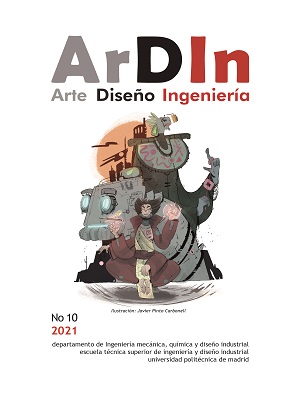¿Quién lidera la era de la digitalización? = Who leads digitalization era?
DOI:
https://doi.org/10.20868/ardin.2021.10.4533Abstract
Este artículo muestra el valor de los productos y servicios digitales en el contexto actual de crisis sanitaria y económica mundial. Al mismo tiempo, formula varias cuestiones que desarrollan dicho planteamiento, ¿qué países tienen un tejido productivo acorde a las necesidades actuales?¿La inversión público-privada en materia de Innovación guarda una relación directa? Por último, ¿qué disciplinas son las destinadas a liderar la era de la digitalización? Todas estas cuestiones quedan resueltas a través de un análisis exhaustivo de datos macroeconómicos, junto con un estudio multidisciplinar de los factores que intervienen en los procesos de innovación,matizando la importancia que ostenta el diseño como agente transformador de la sociedad.
Abstract
This article shows the value of digital products and services in the current context of the global health and economic crisis. At the same time, it formulates several questions that develop this approach: which countries have an updated productive framework to current needs? Does public and private investment in innovation have a direct relationship? Finally, what disciplines are destined to lead digitalization era? All these issues are resolved through an exhaustive analysis of macroeconomic data, along with a multidisciplinary study of the key factors involved on innovation processes, emphasizing the importance of design as a society-changing agent.
Downloads
References
Banco Mundial (2020). La COVID-19 (coronavirus) hunde a la economía mundial en la peor recesión desde la Segunda Guerra Mundial: Banco Mundial. Recuperado de https://www.bancomundial.org/es/news/press- release/2020/06/08/covid-19-to-plunge-global-economy-into-worst-recession-since-world-war-ii
Bayer, B., Cook, J.W., Steinberg, M. (2013). Legible Practices. Helsinki DesignLab. SITRA. Birkinshaw, J., Lian-Hong Ke, D., de Diego, E. (2019). The Kind of Creative Thinking That Fueled We Chat’s Success: Harvard Business Review. Recuperado de https://hbr.org/2019/10/the-kind-of-creative-thinking- that-fueled-wechats-success
Brand Finance (2020). Global 500 2020. US 500 2020.Tech 100 2020. Europe 100 2020. Germany 100 2020. France 100 2020. United Kingdom 150 2020. Netherlands 50 2020. Switzerland 50 2020. Denmark 50 2020. Finland 25 2020. Recuperado de https://brandirectory.com/rankings/Octubre 2019.
Brown, T. (2009). Change By Design. Harper Collins.
Boztepe, S. (2016). Design Expanding into Strategy: Evidence from Design Consulting Firms. IT, University of Copenhagen, Denmark.
Buchanan, R. (2001). Design research and the new learning. Design Issues. Cornell SC Johnson College of Business, INSEAD, OMPI (2019). Índice mundial de Innovación 2019. Recuperado de https://www.wipo.int/publications/es/series/index.jsp?id=129
Executive Excellence (2011). Por qué florecen los emprendedores en Estados Unidos. Recuperado de http://www.eexcellence.es/index.php/entrevistas/con-talento/alan-d-solomont
Fondo Monetario Internacional (2019). Perspectivas y políticas mundiales. Informe de Octubre de 2019. Recuperado de https://www.imf.org/es/Publications/WEO/Issues/2019/10/01/world-economic-outlook-october-2019
Fondo Monetario Internacional (2020). Actualización de las perspectivas de la economía mundial. Informe de Junio de 2020. Recuperado de https://www.imf.org/es/Publications/WEO/Issues/2020/06/24/WEOUpdateJune2020
Fondo Monetario Internacional (2020). Actualización del informe sobre la estabilidad financiera mundial. Informe de de Junio de 2020. Recuperado de https://www.imf.org/es/Publications/GFSR/Issues/2021/01/27/global-financial-stability-report-january-2021-update
Heskett, J. (2017). Design and the creation of value. New York: Bloomsbury.
Hill, L.A., Brandeau, G., Truelove, E., Lineback, K. (2014). Collective Genius: The Art and Practice of Leading Innovation. Harvard Business Review Press.
Keeley, L., Walters, H. (2013). Ten Types of Innovation: The Discipline of Building Breakthroughs. Wiley.
Merholz, P., Skinner, K. (2016).Org Design for Design Orgs: Building and Managing In House Design Teams.
O’Reilly. Osorio, V. (2020). Garamendi e Isla piden consenso y estabilidad tras la cumbre de CEOE: Expansión. Recuperado dehttps://www.expansion.com/empresas/distribucion/2020/06/25/5ef48003e5fdea55388b45d3.html
Porter, M., Stern, S. (2001). National Innovative Capacity. Harvard Business Review
Verganti, R. (2009). Design Driven Innovation, Changing the Rules of Competition by Radically Innovation what things mean. Harvard Business ReviewPress.
Reichheld, F. (2003) The One Number You Need to Grow. Harvard Business Review. Recuperado de https://hbr.org/2003/12/the-one-number-you-need-to-row Speare-Cole, R.,
Mitevska, T. (2018) Europe’s 100 digital champions: Financial Times. Recuperado de https://www. ft.com/content/6d68a236-e153-11e8-8e70-5e22a430c1ad
Salinas, G. (2020) Lessons from the Pandemic - Brand Value and Leadership in Times of Crisis. Brand Finance. Brand Leadership April 2020.
The Official Board (2020) Philips. The Official Board. Recuperado de https://www.theofficialboard.es/organigrama/philips The Official Board (2020) Tesla. The Official Board. https://www.theofficialboard.es/organigrama/tesla
Verganti, R. (2009) Design Driven Innovation, Changing the Rules of Competition by Radically Innovation what things mean. Harvard Business review Press.
Downloads
Published
Issue
Section
License
ArDIn does not charge authors for processing or publishing an article and provides immediate Open Access to its content. All content is available free to the user or their institution. Users are permitted to read, download, copy, distribute, print, search or link to the full text of articles, or use them for any other lawful purpose, without prior permission from the publisher or author. This is in accordance with the BOAI definition of open access.
- Authors retain the copyright and grant to the journal the right to a Creative Commons attribution / Non-Commercial / Non-Derivative 4.0 International (CC BY NC ND) License that allows others to share the work with an acknowledgement of authorship and non-commercial use.
- Authors may separately establish additional agreements for the non-exclusive distribution of the version of the work published in the journal (for example, placing it in an institutional repository or publishing it in a book).
Unless otherwise indicated, all contents of the electronic edition are distributed under a Creative Commons license.













